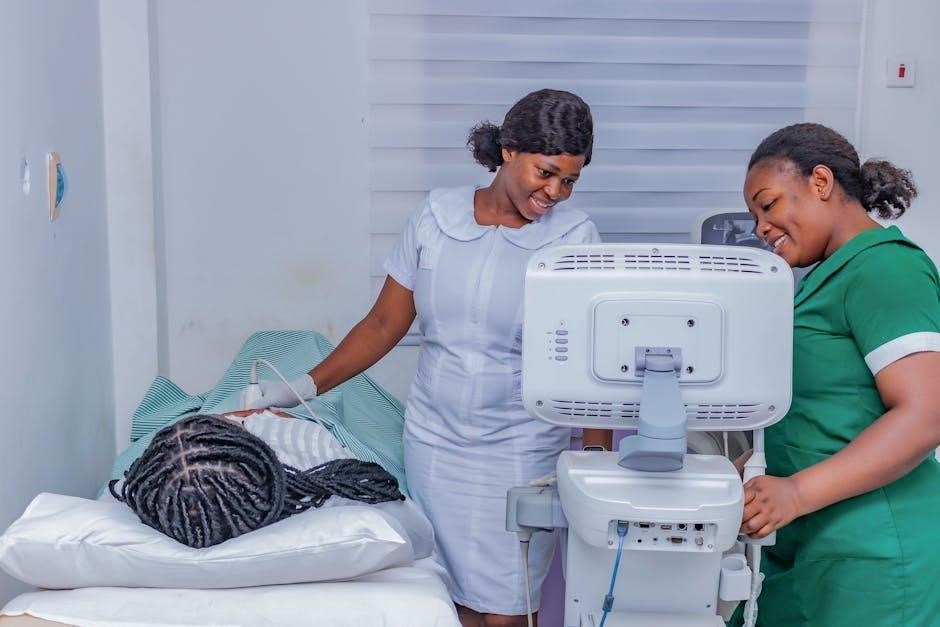
ultrasound guided iv insertion training for nurses
Nursing staff can learn ultrasound guided IV insertion techniques through
specialized
training programs, enhancing patient care with improved insertion success rates and reduced complications, using portable
equipment
effectively always.
Importance of Ultrasound Guided IV Insertion
The use of ultrasound guidance for IV insertion is crucial in nursing practice as it improves the success rate of insertion and reduces complications, according to recent studies and online resources.
By utilizing ultrasound technology, nurses can visualize the vein and surrounding tissue, allowing for more accurate placement of the IV catheter.
This technique is especially beneficial in patients with difficult venous access, such as those with obesity or peripheral vascular disease.
Additionally, ultrasound guided IV insertion can help reduce the risk of nerve damage and other complications associated with blind insertion techniques.
Overall, the importance of ultrasound guided IV insertion lies in its ability to enhance patient care and improve outcomes, making it an essential skill for nurses to master through specialized training programs and online resources.
With the increasing availability of portable ultrasound equipment, nurses can now perform ultrasound guided IV insertions in a variety of settings, from acute care hospitals to home health care.
This has led to improved patient care and reduced healthcare costs, emphasizing the significance of ultrasound guided IV insertion in modern nursing practice.

Benefits of Ultrasound Guided IV Insertion Training
Training enhances nursing skills, improving patient outcomes and reducing complications, with online resources and
portable
equipment supporting education and practice always effectively.
Hands-on Training Programs for Nurses
Hands-on training programs for nurses are essential in mastering ultrasound guided IV insertion techniques, with many institutions offering specialized courses and workshops. These programs provide nurses with the opportunity to practice and refine their skills in a controlled environment, using simulation models and phantoms to mimic real-life scenarios. The training programs are typically designed to cater to the needs of different nursing specialties, including acute care, home health care, and alternate site care settings. By participating in these hands-on training programs, nurses can gain confidence and competence in performing ultrasound guided IV insertions, ultimately improving patient outcomes and reducing complications. The use of portable ultrasound equipment and online resources also supports the education and practice of nurses, enabling them to provide high-quality care in a variety of settings. Overall, hands-on training programs play a critical role in preparing nurses to effectively use ultrasound guidance for IV insertions.
Ultrasound Guided PICC Line and Midline Insertion Training
Teaches nurses to insert and maintain PICC lines and midlines using ultrasound guidance and
specialized
equipment always effectively.
Home Infusion Therapy Nursing Certificate
Home infusion therapy nursing certificate programs are designed to provide nurses with the knowledge and skills necessary to care for patients receiving infusion therapy in the home setting. These programs typically include coursework and clinical training in topics such as infusion therapy principles, patient assessment, and medication management. Nurses who complete these programs are prepared to work in home infusion therapy settings, providing care to patients with a range of conditions, including cancer, infectious diseases, and nutritional deficiencies. The certificate program may also cover topics such as patient education, wound care, and pain management. Upon completion of the program, nurses are eligible to take a certification exam to become certified in home infusion therapy. This certification demonstrates their expertise and commitment to providing high-quality care to patients in the home setting. The program is usually offered by accredited institutions and may be completed online or in a traditional classroom setting, with a focus on hands-on training and real-world application.

Peripheral Intravenous Access Using Ultrasound Guidance
Nurses use portable
ultrasound
equipment to guide peripheral intravenous access, improving insertion success rates and reducing complications always effectively.
Learning Curve and Training Phantoms
The learning curve for ultrasound guided IV insertion can be significant, requiring nurses to practice and hone their skills through training programs and simulations.
Training phantoms, such as ballistic gel or homemade models, can be used to mimic real-world scenarios and help nurses develop their technique.
These phantoms can be used to practice inserting IV lines under ultrasound guidance, allowing nurses to become more comfortable and confident in their abilities.
Online resources, such as video tutorials and forums, can also provide valuable information and support for nurses learning ultrasound guided IV insertion.
By combining hands-on practice with educational resources, nurses can overcome the learning curve and become proficient in this important skill, ultimately improving patient care and outcomes.
Additionally, training phantoms can be customized to simulate different patient scenarios, allowing nurses to practice and prepare for a variety of situations.
This comprehensive approach to training can help nurses master the skills needed for successful ultrasound guided IV insertion.

Implementation of Ultrasound Guided IV Insertion in Nursing Practice
The implementation of ultrasound guided IV insertion in nursing practice requires a multifaceted approach, involving education, training, and policy development.
Nursing leaders and educators play a crucial role in promoting the adoption of this technology, by providing training and resources to nurses.
Guidelines and protocols should be established to ensure consistent and safe practice, and to address potential barriers to implementation.
Portable ultrasound equipment availability is also essential, as it enables nurses to perform IV insertions at the bedside.
Video tutorials and online training courses can facilitate the learning process, and help nurses to develop the necessary skills and confidence.
Moreover, nursing staff should be encouraged to share their experiences and feedback, to continuously improve and refine the implementation process.
By working together, healthcare organizations can successfully integrate ultrasound guided IV insertion into nursing practice, ultimately enhancing patient care and outcomes.
Effective implementation can also lead to reduced complications, improved patient satisfaction, and increased efficiency in nursing practice.